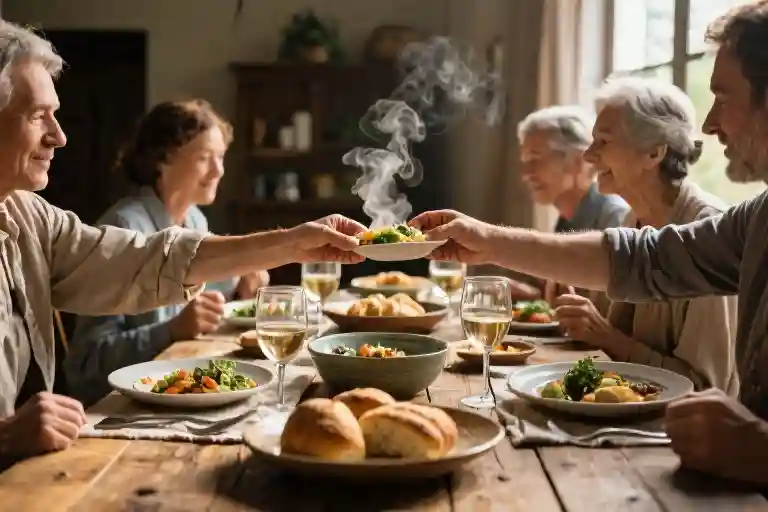The opening scene of The Godfather lingers in cultural memory not for its violence, but for its dining table. Don Corleone conducting business amid plates of pasta, the clink of glasses underlining every unspoken threat—this is where power and intimacy intertwine. That loaded silence between bites speaks volumes about what we’ve surrendered to fast food containers and lunch meetings squeezed between calendar alerts.
Modern statistics paint a bleak contrast: the average American meal now lasts 17 minutes, consumed between screen taps rather than conversations. In Italy, where three-hour lunches remain sacred, obesity rates are half those of the U.S., and depression prevalence sits 23% lower according to WHO data. The numbers whisper what our bodies know—speed devours more than just food.
When was your last meal where cutlery rested untouched as laughter stretched between courses? Not a rushed fuel stop, but those vanishing moments where the table becomes a sanctuary—where teenagers accidentally confess their fears while pushing peas around plates, where aging parents soften over shared desserts. These are the scenes streaming platforms can’t replicate, the human drama no algorithm can curate.
The tragedy of modern dining lies not in what we eat, but how we’ve let the act of eating become transactional. That plastic-wrapped sandwich gulped at your desk carries none of the alchemy that transforms ingredients into connection. Slow food isn’t about organic labels or artisanal cheese—it’s the deliberate choice to let a meal unfold like a good novel, with pacing that allows subplots (and digestion) to properly develop.
The Table: Humanity’s Eternal Stage for Emotion
Some of the most electric moments in storytelling happen around a dinner table. Think of that charged family dinner in The Godfather where Michael Corleone seals his fate, or the elaborate meals in Downton Abbey where every lifted fork conveys unspoken tensions. These scenes resonate because they mirror our deepest human truths—the table isn’t just where we eat, but where we negotiate power, confess secrets, and occasionally, find redemption.
In Ang Lee’s Eat Drink Man Woman, the opening sequence of Chef Chu preparing an elaborate Sunday feast becomes a visual symphony of care and frustration. The trembling hands of his aging father trying to taste the soup tell us more about filial love than any dialogue could. Across cultures and eras, storytellers instinctively return to this setting when they need to show relationships in their rawest form. The table’s flat surface becomes an arena where everything from inheritance disputes to marriage proposals play out with food as both witness and accomplice.
Literature amplifies this symbolism. The crab banquet in Dream of the Red Chamber isn’t merely about delicacies—it’s a meticulously staged display of social hierarchy where every seating arrangement and serving order reinforces the Jia family’s crumbling power structure. Similarly, the banana company massacre in One Hundred Years of Solitude gains its surreal horror from occurring during a workers’ meal, turning sustenance into a weapon of oppression.
These artistic representations didn’t invent the table’s significance—they observed what cultures have known for millennia. In southern Spain, the sobremesa tradition stretches lunch into hours of post-meal conversation where the wine flows slower than the stories. Italian villages still practice the Slow Food movement’s ethos, where a single lunch might involve five courses served over an afternoon, with produce harvested that morning from nearby fields. There’s wisdom in this deliberate pacing—meals become temporal islands where smartphones feel like intruders and the only urgency is another pour of olive oil.
What makes these scenes unforgettable isn’t the food itself (though cinematic close-ups of steaming dumplings certainly help), but the unspoken contract they represent: For these hours, we agree to be fully present. The table demands our attention in ways that cafes and offices can’t—elbows on the wood, napkins in laps, all eyes at the same level. It’s the last truly democratic space where CEOs and interns chew at the same speed.
This universality explains why disrupted meals carry such narrative weight. When Shakespeare needs to foreshadow betrayal in Macbeth, he has Banquo’s ghost crash the banquet. The most unsettling moment in The Shining isn’t the blood elevator, but Jack Torrance’s increasingly unhinged dinner table monologues. These violations of mealtime sanctity disturb us because they break humanity’s oldest social contract—the shared understanding that breaking bread together should be safe.
Modern life has diluted this ritual without erasing our longing for it. We might snack at desks or scroll through dinners, but our pulse still quickens when films show linen napkins being unfolded. That visceral response is nostalgia for something we may have never truly experienced—meals where no one glances at clocks, where second helpings matter more than deadlines, where the dessert course arrives only when the laughter reaches its natural pause.
Perhaps this explains the recent resurgence of communal dining experiences, from underground supper clubs to TikTok-famous ‘dinner party revivalists.’ They’re not selling food so much as the chance to inhabit those cinematic moments we’ve collectively fetishized—to be extras in our own Babette’s Feast or Big Night. The table remains our most reliable time machine, capable of transporting us backward to childhood kitchens or forward to imagined futures, all between the salad and the cheese plate.
The Science Behind Slow Dining
That lingering Sunday lunch where conversations meander like a lazy river, where the third cup of coffee arrives before anyone thinks to check the time—these aren’t just pleasant moments. Oxford researchers quantified what our grandmothers knew instinctively: people who regularly share meals scoring 23% lower on loneliness scales in their 2019 study. The magic isn’t in the food itself, but in the shared rhythm of cutting, chewing, and conversing at a pace that allows eye contact and half-formed thoughts to blossom.
Tokyo University’s 2021 chewing experiment revealed something fascinating. Participants who took 30 chews per bite not only absorbed 15% more nutrients but reported something unexpected—they began noticing flavors in everyday foods they’d previously swallowed without thought. The mechanical act of slowing down created neurological pathways for mindfulness that extended beyond the dining table. It’s as if our taste buds become training wheels for presence.
Then there’s the Chicago community case that reads like urban poetry. A neighborhood grappling with gang violence began organizing monthly potlucks in a reclaimed parking lot. Over two years, emergency calls dropped by 37% in the surrounding blocks. The police chief’s report noted an unexpected factor: residents who broke bread together started recognizing each other’s teenagers. That simple act transformed ‘suspicious loiterers’ into ‘the Johnson boy who makes killer cornbread.’
What these studies whisper is that slow food functions as social glue. The act of chewing becomes meditative when synchronized with others—a biological metronome setting the tempo for connection. It’s not about lavish spreads or perfect table settings, but the deliberate pacing that allows a thirteen-year-old to finally mention their school project during the salad course, or a neighbor to admit they’ve been unemployed over shared dessert.
Modern nutrition science keeps rediscovering what traditional cultures never forgot: digestion begins in the atmosphere. Italian grandmothers could’ve told researchers that stressed bodies absorb nutrients poorly, that laughter literally helps break down food. The Tokyo study just added EEG readings to prove nonna’s wisdom—brainwaves during communal meals show patterns identical to light meditation states.
Perhaps most compelling is how these benefits compound. The Oxford team found that each additional slow meal per week delivered disproportionate returns—like relationship interest accruing daily. Those reporting two shared meals weekly showed only slightly better outcomes than one, but four meals produced dramatic improvements in emotional resilience. It suggests there’s a critical mass where slow dining stops being an activity and starts reshaping neural pathways.
All this research circles back to a simple truth our screens have made us forget: breaking bread was never just about nutrition. It’s the original social network, wired directly into our biology. When we slow our forks, we’re not just feeding bodies—we’re rebuilding the connective tissue modern life has eroded, one deliberate bite at a time.
The Slow Food Playbook: From Screen to Table
That moment in The Godfather when Don Corleone gathers his family for dinner isn’t just cinematic brilliance—it’s a masterclass in how shared meals forge unbreakable bonds. The clinking glasses, the overlapping conversations, the way arguments simmer and resolve between courses. We instinctively recognize these scenes as special, yet most modern meals resemble hurried pit stops rather than intentional gatherings.
Family Edition: Rewriting the Dinner Script
Wednesday nights at our house transformed when we instituted “Childhood Food Story Night.” The rules are simple: each family member prepares one dish tied to a childhood memory, then shares the story behind it during dinner. Last week, my spouse made lumpy mashed potatoes identical to his boarding school days, while our seven-year-old proudly served “dinosaur chicken nuggets” with a tale about her first sleepover. The meal lasts precisely two hours—no watches allowed, just the gradual emptying of plates and filling of hearts.
A wicker basket by the doorway serves as our phone graveyard. Dropping devices in feels like shedding armor; suddenly we notice how our teenager’s voice cracks differently when describing her cafeteria trauma, or how grandfather’s hands tremble less when passing the salt. These nuances get lost in the digital noise of regular meals.
Community Blueprint: The Art of the Long Table
Organizing a neighborhood long-table dinner requires more goodwill than resources. We repurposed sawhorses and plywood into a thirty-foot table, covered with mismatched bedsheets that somehow made the potluck spaghetti taste richer. The genius lay in the “Three-Course Life” icebreaker: appetizer round shares a food-related childhood memory, main course reveals a current challenge, dessert course articulates a hope. By the tiramisu course, the retired accountant was teaching salsa moves to the college barista.
Essential supplies for 50 people:
- Twinkle lights (dollar store strands work)
- Chalkboard signs for dietary labels
- A “conversation menu” with prompts like “What fruit would describe your mood today?”
Solo Rituals: Dining with Your Best Self
Eating alone doesn’t necessitate speed. I set my single placemat with the good silverware—the heirloom pieces with floral engravings that catch afternoon light. A five-minute eating meditation begins each meal: noticing the crunch of celery like autumn leaves underfoot, the way tomato soup coats the spoon in orange velvet. Sometimes I pretend I’m being interviewed about this fictional memoir-worthy meal. “Yes,” I tell the imagined NPR host, “the burnt toast absolutely represents my resilience.”
This isn’t performance art; it’s recalibration. When we eat with the same intentionality we reserve for important meetings or first dates, even leftovers become sustenance for the soul as well as the body. The slow food movement starts not in Italian vineyards but in our willingness to treat nourishment as ceremony rather than refueling.
When Slow Food Becomes Life Philosophy
The act of eating slowly with intention does more than improve digestion—it rewires our relationship with time itself. What begins as a deliberate chewing rhythm soon permeates other aspects of living, creating unexpected bridges between the dining table and daily existence. This isn’t about culinary elitism, but rather recognizing how our approach to nourishment mirrors our approach to life’s banquet.
Consider the parallel movements of slow food, minimalism, and mindfulness. All three share a common enemy: the illusion that faster equals better. Where minimalism strips away physical clutter to reveal what truly matters, slow food removes the hurry from nourishment to rediscover its social and sensory dimensions. Mindfulness then becomes the thread connecting them—being present with your possessions, with your meal, with this very breath. The Japanese tea ceremony embodies this triad perfectly: few utensils (minimalism), deliberate pacing (slow food), and total presence (mindfulness).
Resisting fast food culture requires more than personal choice—it demands collective action. Supporting local farmers markets creates ecosystems where slow food can thrive, transforming grocery shopping from transactional to relational. When you know the hands that planted your carrots, eating becomes an act of participation rather than consumption. Some communities take this further with crop-sharing programs, where members receive seasonal produce while sharing farmers’ risks and rewards. These models don’t just provide ingredients; they rebuild the severed connection between land and table.
Technology often gets blamed for rushed meals, but it can also be harnessed for slow food advocacy. Apps now map local food cooperatives, while social media groups organize ‘slow potlucks’ where attendees commit to device-free, two-hour shared meals. Even virtual dinner parties have emerged, with participants across time zones cooking the same recipe while video-chatting—proof that slow food adapts without compromising its essence.
The most radical aspect of slow food philosophy might be its quiet rebellion against productivity obsession. In a world that glorifies ‘hustle,’ choosing to simmer a stew for hours or linger over conversation becomes political. These acts declare that some things—flavor development, relationship building, personal well-being—cannot be accelerated. Like the tortoise’s race against the hare, slow food’s victory comes not from speed but from understanding what the finish line truly represents.
Perhaps this explains why so many religious and philosophical traditions center around shared meals. From Jewish Sabbath dinners to Buddhist alms gatherings, these rituals recognize that eating together at human pace fosters something beyond nutrition—it nurtures our capacity to be fully alive. Your next meal, then, isn’t just another item on today’s agenda. It’s an invitation to practice living at the speed of connection.
The Table as Life’s Unscripted Stage
Some of the most electric moments in storytelling happen around dinner tables—the hushed tension before Michael Corleone retrieves the gun in ‘The Godfather,’ the chaotic warmth of the Weasley family meals in ‘Harry Potter,’ or the silent understanding exchanged over steaming bowls in ‘Eat Drink Man Woman.’ These scenes resonate because they mirror something primal: the table as humanity’s original stage for unscripted connection.
Yet modern life has turned meals into transactional pit stops. The average American family dinner now lasts 20 minutes—often with screens as uninvited guests. What gets lost in this efficiency is the slow unfurling of relationships that happens when people linger over shared plates. Communal dining isn’t just about sustenance; it’s where inside jokes crystallize, generational wisdom gets passed with the salt shaker, and conflicts soften in the steam of soup.
Perhaps you remember a meal like this—the kind where the clock stopped mattering. Maybe it was a childhood Sunday dinner with grandparents telling embellished stories, or a college midnight snack session that turned into soul-baring. These are the meals that stitch themselves into our personal histories.
Here’s an invitation: think of your last truly present shared meal. Not the hurried lunch between meetings, but one where the conversation had room to breathe. If you’re struggling to recall, you’re not alone. A 2023 Pew Research study found 63% of adults rarely experience meals lasting over an hour with others. But the cost of this loss is measurable—neuroscience shows shared meals activate mirror neurons that build empathy, while sociological data links frequent family dinners to lower rates of adolescent depression.
The table’s magic works in ordinary moments too. It’s in the way coworkers decompress over Friday pizzas, how book club debates get spicier with dessert, or how neighbors become friends during block party potlucks. These gatherings don’t need silver candelabras—just the deliberate choice to slow down together.
Your turn: what’s the meal that lives rent-free in your memory? The one where the food was secondary to the feeling? Share it in the comments—not just the menu, but the laughter that interrupted bites, the silence that spoke volumes, the accidental life advice between courses. Because every great meal leaves leftovers in the heart.





